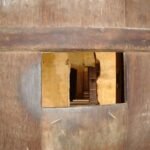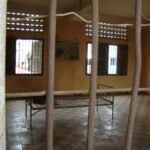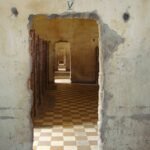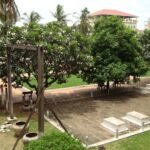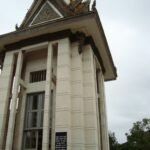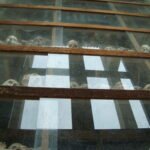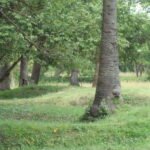Two Backpacks
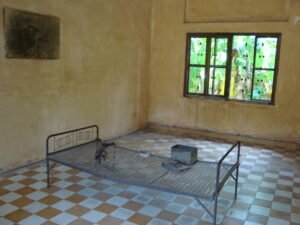
Chapter 13 - Historic horrors of Phnom Penh
We’re on the road again! It was fun catching up with my brother and his Thai family but I’m pleased to be travelling once more.
Air Asia serves us well with cheap, on-time flights from Bangkok to Kuala Lumpur and then Phnom Penh. With our British passports, obtaining our thirty-day tourist visa on arrival is easy.
It’s late afternoon when our airport taxi pulls up in front of an old, dilapidated, three-storey building. I’ve booked four nights at the Sunday Guest House in the city’s centre, a bargain at eight dollars a night. I’m worried I’ve made a mistake in going for something so cheap.
Our room is on the top floor. The building is hot and humid. Ron and I lump our packs up the narrow, twisting staircase.
The bedroom door hits the end of the double bed when Ron opens the door. There’s no window, only a floor-standing fan. I edge my way around the bed to the far side of the room and turn it on.
‘At least the linen looks clean.’ I’m trying to stay positive, but it’s a struggle when all I yearn for is a deluxe hotel room with all the extras!
‘It’ll be fine. We’re on a budget. We’re only going to sleep here. Most of the time, we’ll be on trips,’ comments Ron, who has already pulled his laptop from his carry bag. ‘At least the internet is okay,’ he adds as he logs on.
It’s pointless unpacking; there’s nowhere to stow anything. Instead, I go in search of the communal bathroom and quickly wish I hadn’t.
‘I don’t think we’ll be taking a shower any time soon,’ I state when I return to our room. ‘I’ve no idea when they last cleaned the bathroom. It’s awful!’
‘Do you want to try and find somewhere else?’ Ron asks. ‘I can check if there’s anywhere nearby if you don’t want to stay here.’
‘There’s nowhere. All the hostels are full, those in our budget, anyway.’
Ron switches off his computer and locks it back in his bag.
‘Come on. Let’s go for a walk, explore the neighbourhood and see if we can find somewhere for a beer and supper before it gets too dark.’
I know Ron’s trying to raise my spirits, but it’s going to take more than a beer tonight.
The city streets are clogged by motorcycles, bicycles, cars and trucks. We find a small café off one of the main thoroughfares. We take our seats at a window table and order two beers.
The history of Asia has fascinated me since childhood. Before arriving in Cambodia, I’d read a little about the country’s history. I still remember the harrowing news items from the 1970s, when reports of Khmer Rouge atrocities made the headlines in the United Kingdom.
‘Do you remember anything of what happened back in the seventies?’ I ask Ron.
‘Not much. I was having too much fun to notice what was going on over here,’ he replies.
‘Did you know Phnom Penh came into being because of a local woman, Daun Penh? She lived in a village called Chaktomuk and was collecting firewood on the river bank when she saw a floating koki tree. Somehow, she managed to pull the tree from the water and inside, found four Buddha statues and one of Vishnu.’
‘The artefacts were housed in a shrine on top of a hill. In Khmer, hill is ‘Phnom’, so the area became known as Phnom Penh. At the time, the country’s capital was Angkor Thom, but people believed the discovery was a sign the Khmer capital should move to Phnom Penh.’
We sit together in silence for a while. It’s difficult to imagine the horrors that occurred forty years ago in this now tranquil section of the city.
Tomorrow we’re going to S21 and the Killing Fields. Being a tourist in such places makes me uncomfortable, but they are part of my history. I feel it’s important to understand more of what went on and why.
**********
When the Vietnam War raged (1955-1975), Cambodia was used by the People’s Army of Vietnam, the Viet Cong and thousands of refugees from across the country as a base to escape the fighting. In 1974, when the population of Phnom Penh was thought to be approximately three million, the Khmer Rouge cut off supplies to the city.
When Phnom Penh fell on 17th April 1975, the Khmer Rouge forcibly evacuated the entire city and put the people to work on rural farms, calling them ‘new people’.
Pol Pot, the Khmer Rouge leader, ordered the Tuol Sleng High School to be turned into a prison camp – S21, there Pol Pot and the Khmer Rouge detained those considered educated spies or political enemies. Those who survived the torture in S21 were marched nine miles to Cheoung Ek, one of the many sites in Cambodia known as the Killing Fields.
**********
With help from our hostel manager, we hire a tuk-tuk to take us to the notorious school known as S21.
Our motorised carriage weaves through the narrow streets of the city’s suburbs and pulls up at the entrance to the school.
Standing on the hard, dirt road, I’m taken back by the appearance of normality of the school; three large, white-painted, breezeblock buildings. But nothing about the site is normal; there are no trinket sellers, no touts for tickets, only an unsettling stillness and a barbed wire fence guarding the school’s perimeter.
I take Ron’s hand. We walk together through the entrance hall and into the inner courtyard. The main building is three storeys high, with a balcony running the length of each floor.
‘Can you feel the spirits of all those poor souls murdered here?’ I ask, turning to Ron. I’m close to tears.
He puts his arm around me and draws me to him. There’s an overwhelming sadness that stifles the need for speech.
We follow our guide towards Building A. He tells us this is where prisoners were brought to be tortured, their screams muffled by the paned windows. The walls are bare. A rusted wrought iron bed frame stands alone in each tiny room.
‘Prisoners were manacled hand and foot to the bed, beaten and tortured until they ‘confessed’ or died in the process. Once the Khmer Rouge had the names of the prisoners’ family members and close associates, they were arrested, tortured and killed. Over twenty thousand prisoners were processed here,’ our guide explains.
The silence is eerie, disturbing, and heartbreaking as we take in the enormity of the atrocities that occurred here.
In the courtyard, our guide continues, ‘Buildings B and C housed the prisoners. You’ll see, once you enter, how small the cells are. It was impossible to lie down. Prisoners either had to squat or stand. All were manacled to the floor and had only a metal bowl and metal box – the bowl for eating, the box for human waste.’
‘When Phnom Penh was liberated in 1978, only fourteen prisoners remained in S21. Their throats had been cut. The liberating army found them and placed the bodies in graves in the schoolyard.’ Our guide indicates where fourteen headstones stand on the far side of the courtyard.
‘Since the liberation, no work has been carried out on the site. It remains a constant, grim reminder of man’s inhumanity to his fellow man.’
Our guide departs, allowing us to wander through the remaining two buildings at our own pace.
Our visit to S21 has left both Ron and me unsettled.
‘Let’s head back to the hostel, grab something to eat and call it a day,’ Ron says, echoing my thoughts.
The following morning, after a breakfast of scrambled egg, toast and coffee, Ron and I clamber into a tuk-tuk for the ride to the Killing Fields at Choeung Ek.
After the harrowing day spent at S21, I feel more prepared to face what lies ahead today. My resolve is short-lived. Approaching the site, we see a tall Buddhist stupa; it is the shrine built to honour all those who died in the surrounding orchards at the hands of the Khmer Rouge.
We pay our entrance fee and wander through the tranquil, well-tended gardens surrounding the stupa.
‘I’m not sure I want to go inside,’ I tell Ron, knowing he has the same misgivings. Neither of us wants to see the horrors that lay inside.
‘It’s part of history in our lifetime, not something that happened hundreds of years ago. We must acknowledge what went on here,’ I say, trying to sound more courageous than I feel.
We walk through the central doorway and find ourselves surrounded by more than five thousand human skulls and bones. The shelves holding these relics reach high above us. It’s the first time I’ve seen actual human remains. It disturbs me immensely.
We only spend a short time in the shrine. Outside again, I breathe in the sun-warmed air and try to relax, but in this place, it’s impossible. I know images will haunt me for the remainder of my days.
Ron and I walk through the surrounding orchard. Pieces of fabric lay partly exposed, remnants of victims’ clothing. I clutch Ron’s hand as we notice the knuckled end of a bone poking through the mud around a mass grave.
The authorities have decided to leave the site untouched, a reminder to all who visit of what happened in those awful times.
Choeung Ek is not somewhere you want to linger, but it is somewhere everyone should visit.
